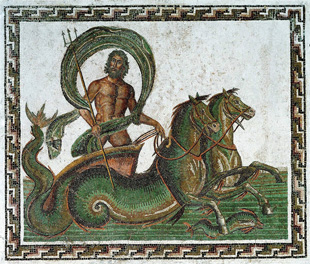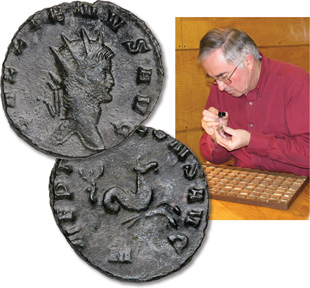
Neptune’s Steeds
In ancient Rome, the seahorse probably inspired the mythical creature called a Hippocampus: hippo (horse) + campus (sea monster). While in New Orleans, I spotted this reference at a seahorse exhibit in the Aquarium (also a Roman word). Romans believed seahorses had the power to cure baldness and a seahorse boiled in wine was poison.
Some sources describe the hippocampus as having the head and forequarters of a horse and the tail and hindquarters of a dolphin. Neptune's chariot was pulled through the ancient seas by several of these creatures. Sometimes Neptune was seen riding one.

Neptune driving a chariot of hippocamps (Roman mosaic)

This bronze Antoninianus of Gallienus features the mythical hippocampus on the reverse
Here's a hippocampus appearing on the reverse of a bronze antoninianus of Roman emperor Gallienus, issued circa A.D. 267-268, with a reverse legend referring to Neptune, NEPTVNO CONS AVG (Neptuno Conservatori Augusti). This roughly translates as "Neptune, the Preserver," and was a cry for help from Gallienus to Neptune to preserve Gallienus against the usurper general Aureolus, an ally of Postumus. It didn't work, as Gallienus was lured to his death by his own troops, including Claudius II Gothicus, Marcianus and Aurelian, as Gallienus led them against Aureolus. Claudius became emperor in his place.

